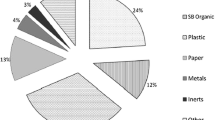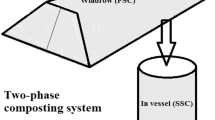Abstract
The reduction and stabilization of biodegradable waste were studied using three operational stages in an aerobic stabilization system. The system used for mechanical/biological treatment utilized two-shaft screws in multiple box reactors. In the first operational stage, 50-kg batches of biodegradable waste were charged in each of the three reactors, with peat moss used as a bulking agent. Analysis revealed that peat moss can be used at this initial stage, based on the observed increase in temperature and carbon dioxide levels. The second stage of operation involved adding 100 kg/day of biodegradable waste to the first reactor. It was confirmed that a continuous reaction is possible by the addition of more waste. In the third stage of operation, 20 kg/day of the 100 kg/day of biodegradable waste feed was replaced with material fed back from the third reactor. At this stage, final product was also removed from the third reactor. The temperature was not controlled, and up to 8%–9% carbon dioxide was formed, enabling normal activation of decomposition. This three-stage operational test confirmed the expected decomposition of organic matter and biodegradable materials. The rate of mass reduction calculated for the final product compared with the input amount was 94.3%, which confirmed that this system would be a useful means for the reduction and stabilization of biodegradable waste. This study also measured the water content of the material in the reactors: the water content decreased as the reaction progressed. This indicated that the activation of microorganisms did not occur sufficiently in the second and third reactors. Future studies of methods to control the internal water content of each reactor should improve the decomposition efficiency.
Similar content being viewed by others
References
Guermoud N, Ouadjnia F, Abdelmalek F, Taleb F, Addou A (2009) Municipal solid waste in Mostaganem city (Western Algeria). Waste Manag 29:896–902
Taseli BK (2007) The impact of the European Landfill Directive on waste management strategy and current legislation in Turkey’s Specially Protected Areas. Resour Conserv Recy 52:119–135
Morais JA, Ducom G, Achour F, Rouez M, Bayard R (2008) Mass balance to assess the efficiency of a mechanical-biological treatment. Waste Manag 28:1791–1800
Einola JM, Karhu AE, Rintala JA (2008) Mechanically-biologically treated municipal solid waste as a support medium for microbial methane oxidation to mitigate landfill greenhouse emissions. Waste Manag 28:97–111
Lornage R, Redon E, Lagier T, Hebe I, Carre J (2007) Performance of a low-cost MBT prior to landfilling: study of the biological treatment of size-reduced MSW without mechanical sorting Waste Manag 27:1755–1764
Son YS, Kim JC, Kim KH, Lim BA (2007) The composition of odor compounds emitted from municipal solid waste landfill. J Korean Soc Atmos Environ 23(6):666–674
Kwon SH, Ban JS, Kim SJ, Phae CG, Kim JD (2009) Effect of food waste content on aerobic stabilization reaction in MBT system. Korea Soc Waste Manag 26(1):21–28
Ban JS, Kwon SH, Phae CG, Kim JD (2009) Effect of temperature control on biodegradation in aerobic stabilization reactor of MBT system. Korea Soc Waste Manag 26(3):21–28
Park JK, Song SH, Jeong SR, Jung MS, Lee NH, Lee BC (2008) Size distribution and physicochemical characteristics of MSW for design of its mechanical biological treatment process. Korea Org Resour Recyc Assoc 16(1):62–69
Gibert O, Ferguson AS, Kalin RM, Doherty R, Dickson KW, McGeough KL, Robinson J, Thomas R (2007) Performance of a sequential reactive barrier for bioremediation of coal tar contaminated groundwater. American Chemical Society 41(19):6795–6801
Yun SP, Kim KK, Kim SW, Kim JY, Kim JH, Bae SK, Won JC, Lee NH, Lee DH, Jang SH, Jung YK, Hu K, Hwang SJ (2002) Waste testing methods. DongHwa Technology, Seoul, Korea
Mandal R, Hassan NM, Murimboh J, Chakrabarti CL, Rahayu MHB, Lean DRS (2002) Chemical speciation and toxicity of nickel species in natural waters from the Sudbury Area (Canada). American Chemical Society 36(7):1477–1484
Author information
Authors and Affiliations
Corresponding author
Rights and permissions
About this article
Cite this article
Ban, JS., Kim, SJ., Kwon, SH. et al. Efficiency analysis of reduction and stabilization of biodegradable waste using an aerobic stabilization system. J Mater Cycles Waste Manag 11, 222–228 (2009). https://doi.org/10.1007/s10163-009-0254-4
Received:
Accepted:
Published:
Issue Date:
DOI: https://doi.org/10.1007/s10163-009-0254-4




